Part I
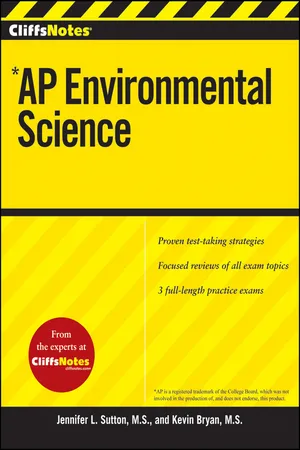
- English
- ePUB (mobile friendly)
- Available on iOS & Android
eBook - ePub
CliffsNotes AP Environmental Science
Frequently asked questions
Yes, you can cancel anytime from the Subscription tab in your account settings on the Perlego website. Your subscription will stay active until the end of your current billing period. Learn how to cancel your subscription.
No, books cannot be downloaded as external files, such as PDFs, for use outside of Perlego. However, you can download books within the Perlego app for offline reading on mobile or tablet. Learn more here.
Perlego offers two plans: Essential and Complete
- Essential is ideal for learners and professionals who enjoy exploring a wide range of subjects. Access the Essential Library with 800,000+ trusted titles and best-sellers across business, personal growth, and the humanities. Includes unlimited reading time and Standard Read Aloud voice.
- Complete: Perfect for advanced learners and researchers needing full, unrestricted access. Unlock 1.4M+ books across hundreds of subjects, including academic and specialized titles. The Complete Plan also includes advanced features like Premium Read Aloud and Research Assistant.
We are an online textbook subscription service, where you can get access to an entire online library for less than the price of a single book per month. With over 1 million books across 1000+ topics, we’ve got you covered! Learn more here.
Look out for the read-aloud symbol on your next book to see if you can listen to it. The read-aloud tool reads text aloud for you, highlighting the text as it is being read. You can pause it, speed it up and slow it down. Learn more here.
Yes! You can use the Perlego app on both iOS or Android devices to read anytime, anywhere — even offline. Perfect for commutes or when you’re on the go.
Please note we cannot support devices running on iOS 13 and Android 7 or earlier. Learn more about using the app.
Please note we cannot support devices running on iOS 13 and Android 7 or earlier. Learn more about using the app.
Yes, you can access CliffsNotes AP Environmental Science by Cliff Notes in PDF and/or ePUB format, as well as other popular books in Study Aids & Study Guides. We have over one million books available in our catalogue for you to explore.
Information
Publisher
Houghton Mifflin HarcourteBook ISBN
9780544179622Subject Reviews
Chapter 1: Earth's Systems and Resources
Earth is a spectacular and ever-changing place, with constant activity and incredible transformations. The changes include everything from earthquakes and volcanoes to the formation of life and extinction of it. This chapter covers Earth's geologic changes and time scale, along with its atmosphere, water, and soil.
Earth
To prepare for the AP Environmental Science exam and to fully understand the concepts and workings of Earth's systems, you need to understand how the planet functions and its composition.
With a unique set of characteristics and features, Earth is the only planet in our solar system that is known to support life. It is the third planet from the sun, with the order of the planets being Mercury, Venus, Earth, Mars, Jupiter, Saturn, Uranus, and Neptune. Although Pluto used to be considered a planet, it is now classified as a dwarf planet.
Geologic Time Scale
At an age of approximately 4.6 billion years, Earth has seen many radical changes throughout its eons, eras, periods, and epochs. This span of time, and the changes that have taken place in it, are grouped into the geologic time scale. On the geologic time scale, eons are the largest spans of time; they include the Archean, Proterozoic, Hadean, and Phanerozoic. The eons Archean and Proterozoic are referred to as Precambrian time with seven eras. Eons are divided into eras, which are divided into periods.
Earth's Structure
With its varying composition and dense core, Earth is layered, and each layer has its own properties. From the interior outward, Earth is composed of a core, a mantle, and a crust.
The crust, the outermost layer of the Earth and the surface on which we live, can be either continental crust or oceanic crust, depending on where it's found. Oceanic crust is denser than continental crust because it is, in large part, made up of basalt, which contains the heavier elements iron and magnesium. The continental crust has a high amount of granite, which is rich in the lighter element aluminum. Because of its brittle nature, the crust can fracture and lead to earthquakes. Continental crust is 22 to 44 miles thick, and oceanic crust is 3 to 6 miles thick.
Below the crust is the mantle, which makes up approximately 80 percent of Earth's volume. It contains the upper mantle and lower mantle. The crust and upper mantle are grouped together in a structure called the lithosphere, which is the rigid outer layer of the Earth. Below the lithosphere but still above the lower mantle is a layer called the asthenosphere, which is made up of a plastic-like substance that tends to flow. The lower mantle is semi-rigid and flows very slowly. Combined, the upper and lower mantle are 1,802 miles thick.
The dense core at the center of the Earth is similarly subdivided into an inner and outer core. The inner core is mainly made up of iron and nickel and is solid because of the extreme pressure from the other layers above it. The liquid outer core is composed mainly of iron and nickel; it is molten because of its extreme heat, which is at least 10,832°F. The outer core is about 1,429 miles thick, and the inner core is 746 miles thick.
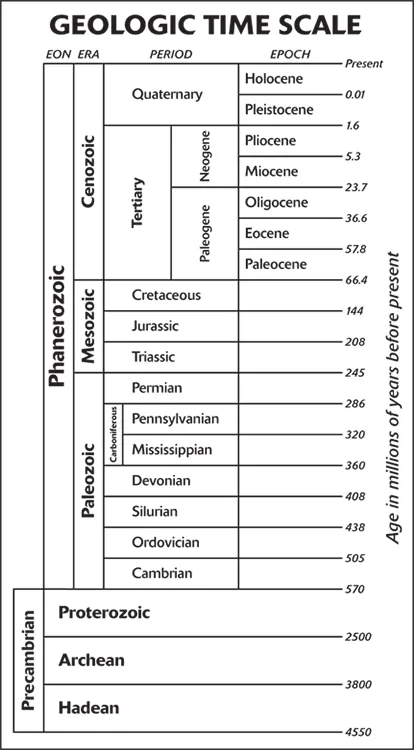
Source: U.S. Geological Survey
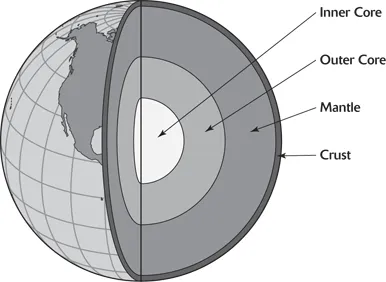
Plate Tectonics
The Earth's lithosphere (the crust and upper mantle) is broken into tectonic plates (also known as lithospheric plates). These plates are in constant motion atop the asthenosphere, which is the Earth's molten mantle layer that keeps the continents slowly moving. This movement of the continents is called continental drift.
The reason that tectonic plates are in constant motion is a process called seafloor spreading, which is the movement of the seafloor at the mid-ocean ridge. A mid-ocean ridge is the location from which magma (molten rock within the Earth) rises to the surface from the asthenosphere. It looks like a scar across the ocean floor. As the magma pushes through the crust and hardens, new seafloor is created. As new magma surfaces, it pushes away the existing seafloor, causing it to spread and move apart.
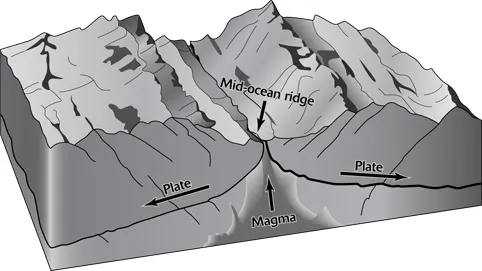
Magma rises through the crust because of convection currents in the magma below the plates. When magma is heated, it becomes less dense and rises, but as it rises it cools, causing it to become denser and sink. As the heating and cooling, rising and sinking process continues, currents are created, and it's this movement that drives the plate motion.
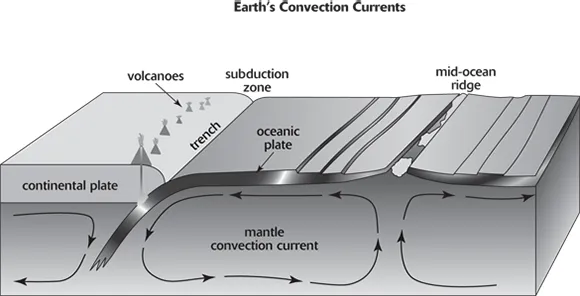
Plate boundaries
At plate boundaries, major geologic activity occurs, including earthquakes, volcanoes, and the formation of mountain ranges. The type of activity depends on the type of plate movement. The three types of plate boundaries are
• Transform plate boundaries: Transform plate boundaries are commonly known as faults and are found on the ocean floor. At the zone of transform plate boundaries, tectonic plates slide in a sideways motion past one another. As they slide and stick, friction and energy build up. When the pressure is eventually relieved, earthquakes can occur at these boundaries. Examples of transform boundaries exposed on land include the San Andreas Fault in California and the Alpine Fault in New Zealand.
• Divergent plate boundaries: When two or more plates pull away from one another, divergent plate boundaries are created. An example of a divergent boundary is the movement of plates at the mid-ocean ridge, where the ocean becomes wider as plates diverge. The East Africa Rift Valley is an example.
• Convergent plate boundaries: When two plates move toward one another, a convergent plate boundary is created as one plate dives under the other. With this collision, different events can follow, depending on the type of crust involved. Examples of convergent boundaries include the Andes Mountains in South America, the Cascade Mountains in the northwestern United States, and the Marianas Trench in the Pacific Ocean.

Oceanic and continental plates
Oceanic and continental plates in collision lead to subduction. Subduction of oceanic plates at plate boundaries is the cause of continental crust being older than oceanic crust. The denser oceanic plate is pushed below the lighter continental plate. When the crust is compacted and pushed up during the collision of two continental plates, mountain ranges are formed. This motion created the Himalaya Mountains, which are still growing today. When two oceanic plates collide, one plate may be pushed below the other, forming a trench or producing a volcano and allowing magma to rise. Formations created from convergent boundaries include the Andes Mountains in South America, the Cascade Mountains in the northwestern United States, and the Marianas Trench in the Pacific Ocean. Earthquakes also can occur as a result of movement at plate boundaries.
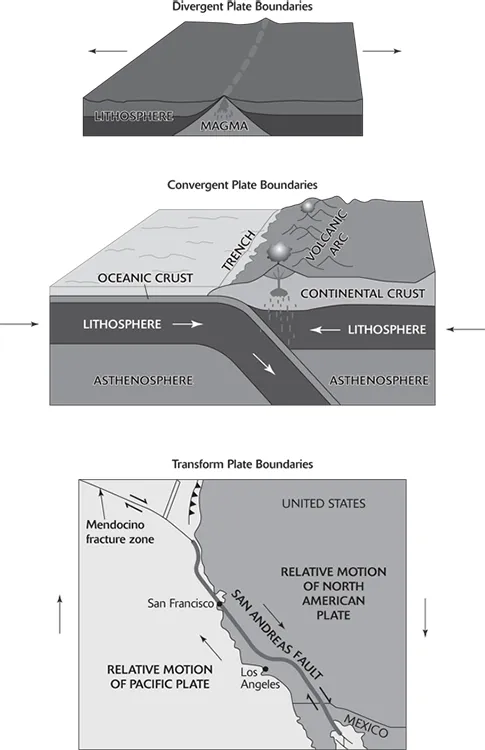
Source: U.S. Geological Survey
Earthquakes
At times, pressure builds up at plate boundaries because of friction from plate movement, and stress is created. When this stress is ultimately discharged, energy is released throughout the Earth's crust, causing vibrations, or earthquakes. Often, earthquakes a...
Table of contents
- Cover
- Table of Contents
- Title Page
- Foreword
- Introduction
- Part I: Subject Reviews
- Part II: Practice Exams
- Part III: Resources